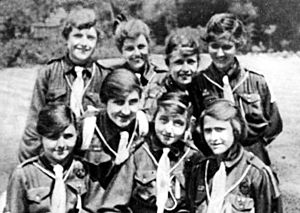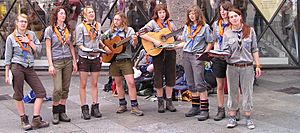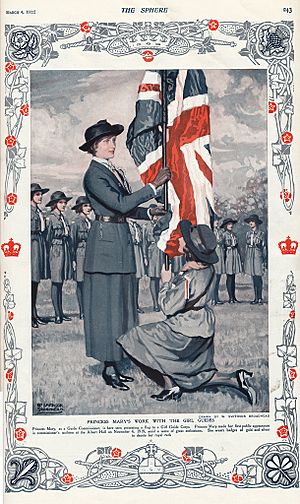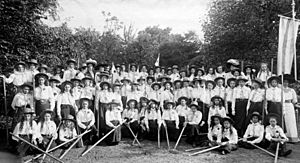Girl Guides facts for kids



Girl Guides or Girl Scouts (in the United States) is a worldwide group mostly for girls and women. It started in 1909 because girls wanted to join the popular Boy Scout Movement.
Over time, the movement grew differently around the world. In some places, girls joined Boy Scout groups. In other areas, girls started their own groups. Sometimes, these groups later welcomed boys or joined with boys' groups. The names "Girl Guide" or "Girl Scout" have also changed in different places and at different times.
The World Association of Girl Guides and Girl Scouts (WAGGGS) began in 1928. It has groups in 145 countries and over 10 million members worldwide. WAGGGS celebrated 100 years of Girl Guiding and Girl Scouting from 2010 to 2012.
Contents
The History of Girl Guides
How Scouting Began
Robert Baden-Powell was a British soldier. He served in South Africa during the Second Anglo-Boer War (1899–1902). During the Siege of Mafeking, he saw how helpful young boys were. They carried messages for the soldiers.
When he returned home, Baden-Powell wanted to test his ideas for young boys. He took 21 boys camping on Brownsea Island in Dorset, England. The camp was a big success. After this, Baden-Powell wrote a book called Scouting for Boys. This book taught skills like tracking, signalling, and cooking. It also showed how to be a "good citizen." Soon, boys started forming their own groups called "Boy Scouts."
Girls Join the Movement
Girls also bought Baden-Powell's book. They formed their own "Girl Scout" groups. Some girls and boys even formed mixed groups.
Back then, it was not common for girls to camp or hike. A magazine from 1909 wondered how a girl could be a Scout if she wasn't allowed to run or swim. But many Girl Scouts still registered at the Scout Headquarters.
In 1909, there was a big Boy Scout event in London called the Crystal Palace Rally. Thousands of Boy Scouts were there. Several hundred Girl Scouts also attended. A group of girls from Peckham Rye, who didn't have tickets, asked Baden-Powell if they could join.
After some public discussion, Baden-Powell decided it would be best to have a separate group just for girls. He asked his sister, Agnes Baden-Powell, to create this new group. In 1910, The Girl Guides officially started in the United Kingdom. The very first Guide group was 1st Pinkneys Green Guides. Many Girl Guide and Girl Scout groups around the world started from this point.
Why the Name "Guides"?
Baden-Powell chose the name "Guides" from a special army group in India. This group, the Corps of Guides, was known for its amazing tracking and survival skills. In some countries, girls preferred to keep the name "Girl Scouts."
Other important women helped start the movement in different countries. These include Juliette Gordon Low in the USA, Olga Drahonowska-Małkowska in Poland, and Antoinette Butte in France.
Helping Others After War
The Guide International Service (G.I.S.) was a group started by the Girl Guides in Britain in 1942. Their goal was to send teams of adult Girl Guides to Europe after World War II. They helped with relief work.
About 198 Guiders and 60 Scouts from Britain, Australia, Canada, Ireland, and Kenya served in these teams. Some helped people in the Bergen-Belsen displaced persons camp. Others served in Malaya.
All Girl Guide groups share some important things:
- The Guide Promise – Girls become Guides by making a promise. Each country has its own promise. But they all have three main parts: duty to God or your beliefs, duty to your country, and following the Guide Law. While there was a religious part, many promises are now more open to different beliefs.
- The Good Turn – Every Guide tries to do a kind thing for someone else each day. They do it without being asked and without expecting payment.
- The World Badge – This badge can be worn on uniforms or regular clothes. The three leaves of the trefoil (a clover shape) stand for the three parts of the Promise. The line in the middle is like a compass needle, showing the way. The two stars stand for the Promise and the Law. The colors (gold and blue) mean the sun shines over all children from a blue sky. This badge is a symbol recognized worldwide.
- The World Flag – This flag has the same colors as the World Badge. Any member can carry or fly it. It is often used as a group flag. The three yellow blocks show the three parts of the Promise. The white corner means all WAGGGS members want peace.
- The Guide Sign – The three raised fingers stand for the three parts of the Promise. Guides use this sign when they make or renew their Promise. They also use it when meeting other Guides, getting a badge, or at the end of meetings.
- The Motto – "Be Prepared" – This means Guides are ready for anything that might happen.
- The left handshake – This is how members greet each other. The left hand is closer to the heart, showing friendship. Also, warriors held their shield in their left hand. Putting down your shield shows bravery and trust.
- Thinking Day – On February 22 each year, Guides think about their Guide friends all over the world. This date was chosen because it is the birthday of both the Founder and the World Chief Guide.
- The World Centres – There are five special places around the world: Our Chalet in Switzerland; Pax Lodge in London; Our Cabana in Mexico; Sangam in India; and Kusafiri in Africa.
- The World Chief Guide – Olave, Lady Baden-Powell, is the only person to have held this title. She was the wife of the Founder, Lord Baden-Powell. She lived from 1889 to 1977.
From the very beginning, two main ideas have been part of the movement. These are learning life skills and a type of practical independence. This includes physical fitness, survival skills, camping, learning about citizenship, and preparing for jobs. These ideas have been taught differently over time, but they are still very important to Girl Guiding and Girl Scouting.
Guide Uniforms
The uniform is a special part of all Scouting groups. Robert Baden-Powell said it "hides all differences of social standing." This means everyone looks equal, no matter their background. He also said it "covers differences of country and race and creed." This helps everyone feel like they are part of one big family.
In 1909, the first uniform ideas for Girl Guides included:
- A jersey in the group's color.
- A neckerchief in the group's color.
- A dark blue skirt, knickers, and stockings.
- A red cap (biretta) or a large straw hat in summer.
- A bag (haversack), cooking pot (billycan), lanyard, knife, and walking stick.
- A cape worn on the back.
- A shoulder knot in the group's color on the left shoulder.
- Badges, similar to the Boy Scouts.
- Leaders wore regular walking clothes with a dark blue cap, white shoulder knot, walking stick, and whistle.
Today, Guide uniforms change based on different cultures, climates, and activities. They often have badges that show a Guide's achievements and duties. In some places, companies make and sell the uniforms. In other places, members make their own uniforms.
See also
 In Spanish: Guidismo para niños
In Spanish: Guidismo para niños


